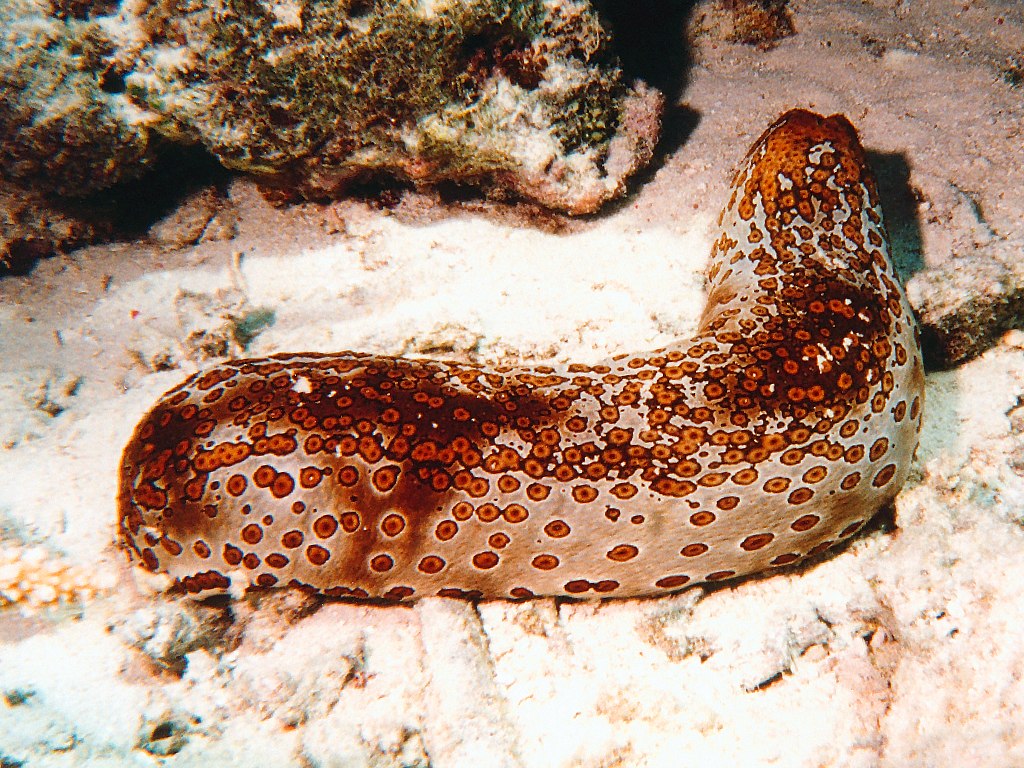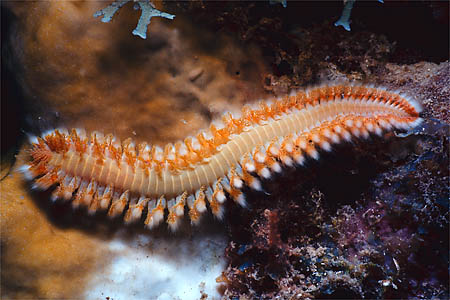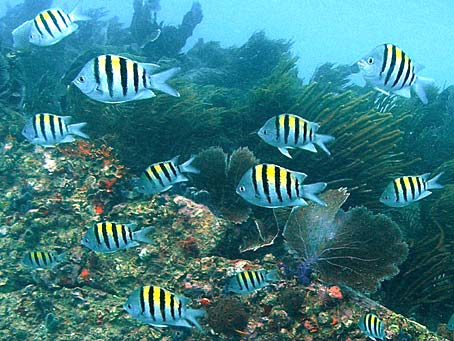On Tuesday, we went to Fowey Rocks to go snorkeling. We saw various marine organisms, including squid, barracudas (Great Barracuda: Sphyraena barracuda), crabs, fire coral and numerous species of fish. The lighthouse also had a great frigatebird (Fregata minor) flying above us.
Fregata minor almost never touches land and thus spends most of his/her life flying above oceans. The only time this bird touches land is for mating. The female chooses the male(s) while males display sounds and a red pouch on their chest filled with air and blood vessels. It is unclear why the females think another male is better suited/more attractive for reproduction. Scientists believe it is because of MHC (Major Histocompatibility Complex) where a group of genes are highly polymorphic (various copies of alleles). If a bird has a different variety of genes, then that bird will have a better immune system. Other interesting facts about the Fregata minor is that this bird is slow to mature, therefore having a very long lifespan and cares for a newborn for up to 18 months.
Marine debris are destroying the ocean. This includes plastic, cigarette buds and overall trash/waste. The fishing industry intentionally/accidentally dumps nets into the ocean and causes animals to have limited mobility, limited fitness, starvation, injuries, infection and suffocation. Sea turtles confuse plastic for jellyfish and ingest plastic. Birds eat trash and feed it to their young. Corals catch waste because of its 3D structure. Marine mammals are playful and curious, causing them to get accidentally entangled and die from starvation and/or suffocation. Beaches are getting filled up with trash. Please recycle, reuse and reduce.
Another interesting fact that I learned is that an obvious way to tell the difference between seals and sea lions is that seals have small holes for ears, while sea lions have actual ears. A manatee has a paddle-like tail while a dugong has a horizontal tail that is identical to whales or dolphins.
Summer Scholar Program: Marine Science
Thursday, July 15, 2010
Monday, July 12, 2010
Hardbottom Community Snorkeling
Today, our marine science group went snorkeling to a hardbottom community. A hardbottom is a type of coral reef community that is close to the shore and is dominated by algae, corals and other organisms. We went around an island and the currents at first were gently gliding us towards the forward direction and ended up pushing us away from the boat in the end. It was very hard to snorkel when the entire class was literally clinging on to rocks and anything else they can grab onto.
We saw many marine organisms including brain coral, brittle stars, sea urchins (Diadema antillarum), mollusks, sea cucumbers, a lobster, a fire worm, and Sergeant Major fish. While we were on the boat ride back, we saw a dolphin swimming!
Tomorrow we get to swim in open water. It will probably remind me of the movie Jaws, as anything with murky water ends up with a shark coming right for that particular person.
We saw many marine organisms including brain coral, brittle stars, sea urchins (Diadema antillarum), mollusks, sea cucumbers, a lobster, a fire worm, and Sergeant Major fish. While we were on the boat ride back, we saw a dolphin swimming!
Tomorrow we get to swim in open water. It will probably remind me of the movie Jaws, as anything with murky water ends up with a shark coming right for that particular person.
Friday, July 9, 2010
Exam and Lectures
In today's lecture we learned about various marine organisms. An octopus has excellent vision compared to us(we have a blind spot and they do not). Also, a mimic octopus literally takes the shape and color of other organisms to protect it/scare off predators (or is possibly just a reflex reaction).
The world's smallest fish is Paedocypris.
The world's biggest fish is the Whale Shark.
The world's smallest fish is Paedocypris.
The world's biggest fish is the Whale Shark.
Thursday, July 8, 2010
Snorkeling Gone Wrong
Today, the marine science group went snorkeling. Unfortunately, I got seasick while snorkeling. Hopefully next week's snorkeling trips will be better.
We learned about gravitational pull today for a short lecture. The moon is the primary cause of the different levels of tides. The sun is also a cause, but it isn't as close to the Earth as the moon is, therefore making the gravitational pull of the moon to the Earth stronger. When the Earth, moon and sun are aligned, there is a very high tide and a very low tide.
We learned about gravitational pull today for a short lecture. The moon is the primary cause of the different levels of tides. The sun is also a cause, but it isn't as close to the Earth as the moon is, therefore making the gravitational pull of the moon to the Earth stronger. When the Earth, moon and sun are aligned, there is a very high tide and a very low tide.
Tomorrow is the second exam and it involves water chemistry, physics and oceanic circulation as well as atmospheric circulation, coral reef communities, sea turtles and sediments.
Wednesday, July 7, 2010
Sea Turtles, Manatees and More
Yesterday night, we (the marine science group) went to a science museum and experienced a mother sea turtle laying eggs. While in the science museum, I witnessed hundreds of plants, animals and ecosystems. The organisms included anemones, algae, fish (i.e. sharks, catfish) and of course, sea turtles.
Our group went to the beach to witness a mother sea turtle getting out of the water to find a place for her future sea turtle generation. We were only allowed to get close to her when she was laying her eggs. She seemed quite tired from the long journey out of the water, but she still followed her instincts to keep her eggs protected from bacteria and other predators. The experts said that she was an older turtle. Her age could also mean that she is very experienced at making sure her eggs survive.

Today however, we went to see rescued manatees and other sea animals. While "backstage", animal-loving workers took blood samples and tagged them. There were three grown/still growing manatees and one baby (adorable). Two are supposed to be released into the wild next week. Manatees can stay out of the water for a surprisingly long duration of time but we still helped to keep them cool from Florida's hot, humid temperature by hosing them with cool water for the entire time. Their tails are extremely strong and would sometimes splash water high into the air. One of the manatees was hit by a boat's propeller and was rescued and is now recovering well, with a scar in her lower back. We later saw more manatees for viewers and they were massive.
Our group went to the beach to witness a mother sea turtle getting out of the water to find a place for her future sea turtle generation. We were only allowed to get close to her when she was laying her eggs. She seemed quite tired from the long journey out of the water, but she still followed her instincts to keep her eggs protected from bacteria and other predators. The experts said that she was an older turtle. Her age could also mean that she is very experienced at making sure her eggs survive.

Today however, we went to see rescued manatees and other sea animals. While "backstage", animal-loving workers took blood samples and tagged them. There were three grown/still growing manatees and one baby (adorable). Two are supposed to be released into the wild next week. Manatees can stay out of the water for a surprisingly long duration of time but we still helped to keep them cool from Florida's hot, humid temperature by hosing them with cool water for the entire time. Their tails are extremely strong and would sometimes splash water high into the air. One of the manatees was hit by a boat's propeller and was rescued and is now recovering well, with a scar in her lower back. We later saw more manatees for viewers and they were massive.
Tuesday, July 6, 2010
Tuesday (July 6, 2010)
Today's class consisted of chemistry and physics in Earth's oceans. The day went by slowly and it was hard to stay focused as I didn't find ocean currents as interesting as the organisms that live beneath them. I did find the topic of light and electromagnetic radiation fascinating. Our eyes can only detect certain wavelengths and it was weird to think that species besides ourselves can see other forms of vision. For example, studies have been shown to prove that certain species of birds can see forms of light that we can't even imagine to think of. I now feel like most of the organisms that exist on Earth, including us, are at least half color blind.
Tonight is going to be a long night as we are going to see turtles (hopefully hatching) across a beach. It should be fun!
It was also interesting how animals such as whales communicate through sound that can be heard to other whales on the other side of the globe. Humans are making it more and more impossible to keep that communication going, as pollution and other industrial noise keeps increasing.
Tonight is going to be a long night as we are going to see turtles (hopefully hatching) across a beach. It should be fun!
Friday, July 2, 2010
Friday and Exam 1
Today we had our first exam. I was kind of nervous before I took it, because I didn't know what to expect. I ended up getting an 83 which is good for a college level exam!
We also did a lab today about Globorotalia menardii. This organism is looked like tiny popcorn under a microscope.
Facts learned today in class:
We also did a lab today about Globorotalia menardii. This organism is looked like tiny popcorn under a microscope.
Facts learned today in class:
- The last ice age started 75,000 years ago and ended 10,000 years ago.
- Marine sediments are usually combinations of terrigenous sediments (come from land) and biogenous sediments (come from organisms).
- Sediments are historical records of oceanic processes.
- Hardbottom communities exist where there are strong currents and shallow water.
- Ice (glaciers) reflect heat coming from the sun. The ice on Earth is melting at an increased rate each year which gives scientists the idea that the Earth will greatly increase in temperature in the near future.
- For atmospheric circulation, the Coriolis effect causes the Northern Hemisphere air to turn right and the Southern Hemisphere air to turn left.
Subscribe to:
Comments (Atom)





























